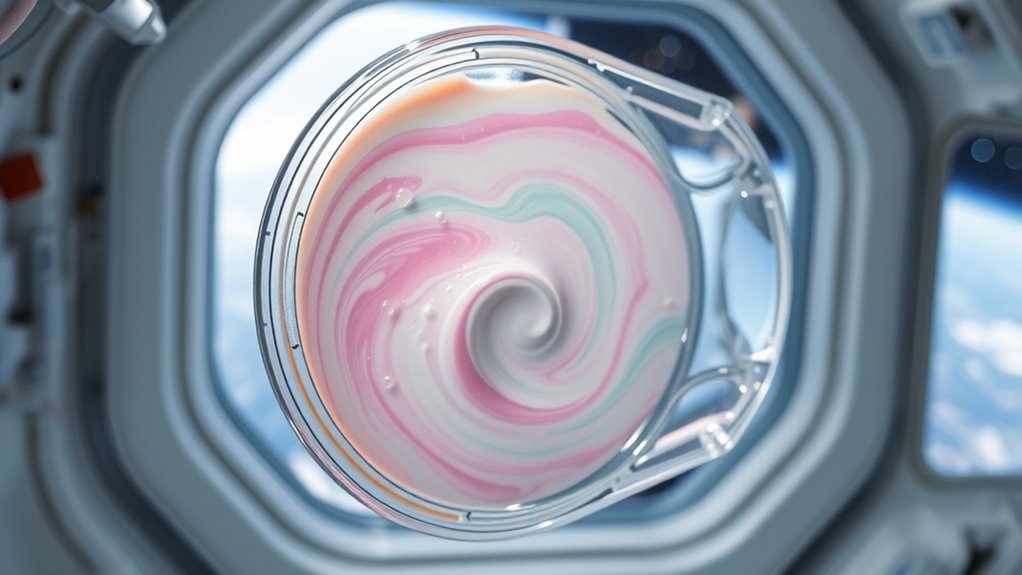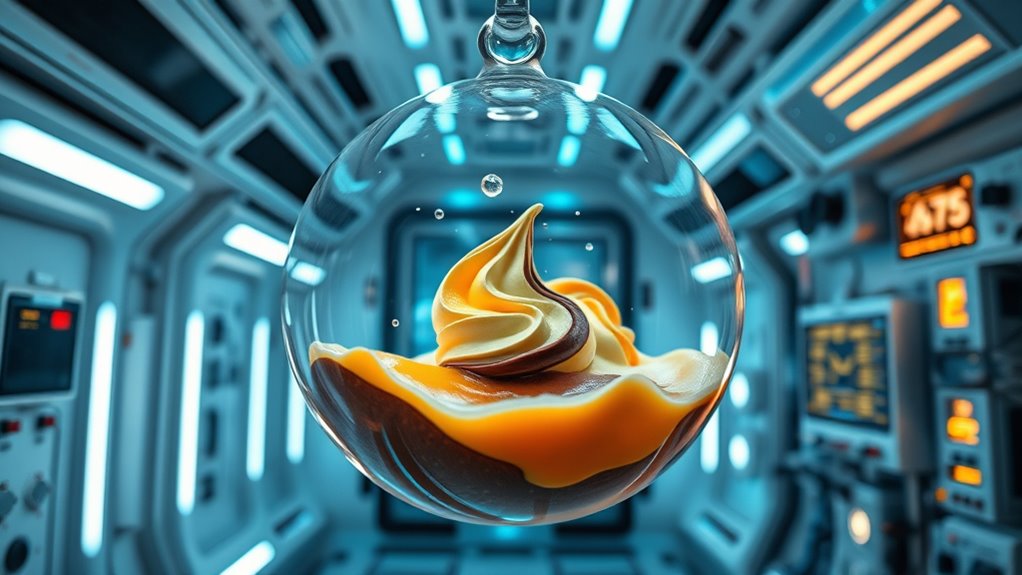NASA’s experiments suggest you can make gelato in space with the right tools and techniques, despite the challenges of microgravity. By using special containers, edible gels, and 3D food printing, astronauts can mix, freeze, and serve space-friendly desserts like gelato. Although it’s complex without gravity, research shows it’s possible to enjoy creamy, frozen treats on future missions. Keep exploring to discover how NASA is turning space desserts into a tasty reality.
Key Takeaways
- NASA’s experiments show that with specialized containers and techniques, making gelato in space is feasible.
- Microgravity prevents liquids from settling, requiring innovative mixing and freezing methods for space gelato.
- Technologies like edible gels and 3D food printers are used to create frozen desserts without gravity.
- Progress indicates that astronauts could enjoy authentic gelato and other frozen treats on future missions.
- Continuous advancements aim to improve space culinary options, enhancing astronaut morale and quality of life.

Have you ever wondered if making gelato in space is possible? The idea of creating delicious, creamy desserts like gelato in the unique environment of zero gravity might seem like a challenge, but it’s actually a fascinating aspect of space culinary. NASA has been experimenting with zero gravity desserts to understand how food behaves in space, aiming to improve astronauts’ diet and morale during long missions. These experiments are paving the way for more complex culinary creations beyond just rehydratable meals. The core issue with making gelato in space revolves around the absence of gravity, which normally helps with the mixing, freezing, and serving processes on Earth.
In zero gravity, liquids don’t settle or separate as they do on Earth. Instead, they form floating blobs or spheres, making traditional cooking techniques impossible. For space culinary, this means that creating a smooth, uniform gelato isn’t straightforward. NASA researchers have been exploring ways to manipulate ingredients in microgravity, often using special containers and devices that simulate the effects of gravity. These tools allow astronauts to combine ingredients, freeze mixtures, and even serve desserts without them floating away. It’s a delicate balancing act—ensuring that the mixture maintains the right consistency and texture for gelato, despite the lack of gravity pulling everything downward.
NASA’s experiments with zero gravity desserts are showing promising results, demonstrating that with the right technology, astronauts can enjoy more than just the standard space food. They’re testing innovative methods like using edible gels, 3D food printing, and specially designed containers to create creamy textures in microgravity. These advancements suggest that, someday, astronauts could enjoy authentic gelato or similar frozen treats in space. The key lies in understanding how to manipulate the ingredients so they freeze evenly and maintain their desired consistency without gravity assisting the process. This research isn’t just about curiosity; it’s about improving quality of life during long-duration missions, making space food more enjoyable and nutritionally complete.
While we’re still in the experimental phase, the progress made in space culinary and zero gravity desserts indicates that making gelato in space isn’t just a flight of fancy. It’s a real possibility driven by scientific innovation and creative problem-solving. As technology advances, the day may come when space travelers indulge in a scoop of gelato, bringing a taste of Earth’s delights to the far reaches of space. So, yes—making gelato in space could very well be part of our future, thanks to ongoing experiments and a deeper understanding of how food behaves beyond our planet.
Frequently Asked Questions
How Does Microgravity Affect Gelato Texture and Flavor?
You’ll notice that microgravity considerably impacts gelato’s texture and flavor. Gravity effects on ingredients mean the mixture doesn’t settle or separate the same way, resulting in a smoother, more uniform texture. Additionally, flavor changes occur because microgravity alters how molecules interact, sometimes intensifying or dulling taste. As a result, gelato in space can be creamier and more consistent, but you might also experience subtle shifts in flavor due to these unique conditions.
What Ingredients Are Used for Making Gelato in Space?
You’d use ingredients similar to traditional gelato, like dairy, sugar, and flavorings, but adapted for space. Space ice cream, a popular space treat, offers insights into flavor preservation in microgravity. To make gelato in space, you’d need to guarantee these ingredients stay stable and maintain their texture despite microgravity’s effects. This way, you can enjoy creamy, flavorful gelato even beyond Earth.
How Is Gelato Stored and Served Aboard Spacecraft?
Imagine space refrigeration as a guardian, preserving your sweet escape. You store gelato in specialized dessert packaging that withstands zero gravity’s chaos. When it’s time to enjoy, astronauts gently peel back the packaging, revealing creamy delight. This clever system keeps the gelato fresh and ready to serve, turning a simple dessert into a moment of comfort amid the stars. You get to savor a frozen treat, even beyond Earth’s bounds.
Are There Any Health Benefits of Eating Gelato in Space?
Eating gelato in space offers some health benefits by enhancing space nutrition and providing dietary variety, which is essential for mental well-being and maintaining muscle mass. The treat can boost morale during long missions, helping you stay motivated. While it’s a sweet indulgence, it also introduces variety to your diet, reducing monotony. Enjoying gelato in space supports both your physical health and emotional resilience during extended space travel.
Can Gelato-Making Techniques Be Adapted for Other Space Foods?
You can adapt gelato-making techniques for other space foods by exploring space dessert innovations and extraterrestrial culinary techniques. These methods focus on managing microgravity effects, improving texture, and ensuring safety. By experimenting with freezing, mixing, and packaging processes, you can develop a variety of space-friendly foods. This approach not only enhances astronauts’ diet but also opens doors for creative, sustainable culinary solutions in space exploration.
Conclusion
So, could you imagine savoring a scoop of gelato while floating in space? NASA’s experiments show that even making treats like gelato is possible, pushing the boundaries of food science beyond Earth. It makes you wonder—what other delicious innovations could astronauts enjoy in zero gravity? As technology advances, tasting familiar desserts in space might become routine, turning the final frontier into a place where sweet dreams—and gelato—are made.
















